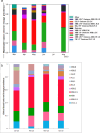Monitoring SARS-CoV-2 variants in wastewater during periods of low clinical case surveillance in Ethiopia
- PMID: 40728295
- PMCID: PMC12379605
- DOI: 10.1128/msphere.00229-25
Monitoring SARS-CoV-2 variants in wastewater during periods of low clinical case surveillance in Ethiopia
Abstract
Wastewater-based genomic surveillance is a cost-effective approach for tracking outbreaks like severe acute respiratory syndrome coronavirus 2 (SARS-CoV-2). A 2023 study in Addis Ababa, Ethiopia, revealed two infection waves in March and August, with the latter undetected by clinical surveillance. This study analyzed the viral spread and evolution in the population during periods of low reported cases. Viral concentration was performed following the Ceres Technology protocol, and RNA was extracted using the QIAamp Viral RNA Mini Kit. Quantitative PCR was performed using the TaqPath COVID-19 Kit. Samples with cycle threshold values ≤32 were used for sequencing. Library preparation and sequencing were performed using the Illumina COVIDSeq protocol, and data analysis was conducted using the Freyja pipeline on Terra.bio. SARS-CoV-2 viral load in wastewater began rising on 6 March 2023, peaking on 16 March 2023, before declining until early May 2023. A resurgence occurred from 3 to 21 August 2023. In March 2023, XBB.1.5 (34%), XBB* (20%), and CH.1.1 (15%) were dominant. By April-May 2023, XBB.1.5 rose to 51% but declined to 14% in June 2023, while XBB* increased to 41%. In August 2023, XBB* (52%) and XBB.1.5 (31%) co-dominated. Key spike protein mutations (G142D, V213G, T478K, S494P, S477N) correlated with higher viral loads. Wastewater surveillance of SARS-CoV-2 reveals seasonal and behavioral transmission patterns. A March peak linked to XBB.1.5 and XBB* saw XBB.1.5 dominance through May 2023, later declining. An August 2023 resurgence with XBB* co-dominance suggests viral evolution and waning immunity. Key spike mutations correlate with higher viral loads, emphasizing wastewater surveillance's predictive value.IMPORTANCEThis study highlights the critical role of wastewater monitoring in detecting and tracking severe acute respiratory syndrome coronavirus 2 (SARS-CoV-2) outbreaks, particularly in regions with limited clinical reporting. Using genomic analysis tools like Freyja enables the detection and monitoring of SARS-CoV-2 variants by untangling mixed signals to track viral evolution and mutations. This unbiased method offers a comprehensive assessment of virus prevalence, including asymptomatic cases, making it a key supplement to clinical surveillance. By addressing gaps and biases in testing, the detection of two distinct viral waves in Addis Ababa, including one missed by patient-based surveillance, underscores the effectiveness of this approach. The shifting dominance of Omicron sub-lineages, such as XBB.1.5 and XBB*, and their spike protein mutations provide essential insights into viral evolution and transmission dynamics. The connection between specific mutations and increased viral loads further suggests potential impacts on viral fitness and transmissibility. These results reinforce the need to integrate wastewater surveillance into public health strategies to support clinical surveillance, enable early detection of emerging variants, and support timely interventions. Moreover, wastewater surveillance can be extended to monitor other pathogens and antimicrobial resistance, making it an essential tool for pandemic preparedness and ongoing public health management.
Keywords: COVID-19; Freyja analysis; SARS-CoV-2; genomic surveillance; wastewater based epidemiology.
Conflict of interest statement
The authors declare no conflict of interest.
Figures





Similar articles
-
Hospital wastewater surveillance for SARS-CoV-2 identifies intra-hospital dynamics of viral transmission and evolution.Appl Environ Microbiol. 2025 Jul 23;91(7):e0050125. doi: 10.1128/aem.00501-25. Epub 2025 Jul 1. Appl Environ Microbiol. 2025. PMID: 40590566 Free PMC article.
-
Prescription of Controlled Substances: Benefits and Risks.2025 Jul 6. In: StatPearls [Internet]. Treasure Island (FL): StatPearls Publishing; 2025 Jan–. 2025 Jul 6. In: StatPearls [Internet]. Treasure Island (FL): StatPearls Publishing; 2025 Jan–. PMID: 30726003 Free Books & Documents.
-
Rapid, point-of-care antigen tests for diagnosis of SARS-CoV-2 infection.Cochrane Database Syst Rev. 2022 Jul 22;7(7):CD013705. doi: 10.1002/14651858.CD013705.pub3. Cochrane Database Syst Rev. 2022. PMID: 35866452 Free PMC article.
-
The effect of sample site and collection procedure on identification of SARS-CoV-2 infection.Cochrane Database Syst Rev. 2024 Dec 16;12(12):CD014780. doi: 10.1002/14651858.CD014780. Cochrane Database Syst Rev. 2024. PMID: 39679851 Free PMC article.
-
Combining analysis of individual and wastewater whole genome sequencing improves SARS-CoV-2 surveillance.Water Res. 2025 Sep 15;284:123953. doi: 10.1016/j.watres.2025.123953. Epub 2025 Jun 3. Water Res. 2025. PMID: 40516408
References
-
- WHO . 2024. Environmental surveillance for SARS-COV-2 to complement public health surveillance. Available from: https://www.who.int/publications/i/item/WHO-HEP-ECH-WSH-2022.1
-
- Fontenele RS, Kraberger S, Hadfield J, Driver EM, Bowes D, Holland LA, Faleye TOC, Adhikari S, Kumar R, Inchausti R, et al. 2021. High-throughput sequencing of SARS-CoV-2 in wastewater provides insights into circulating variants. Water Res 205:117710. doi: 10.1016/j.watres.2021.117710 - DOI - PMC - PubMed
-
- Wang Z, Wu P, Wang J, Lourenço J, Li B, Rader B, Laine M, Miao H, Wang L, Song H, Bharti N, Brownstein JS, Bjornstad ON, Dye C, Tian H. 2022. Assessing the asymptomatic proportion of SARS-CoV-2 infection with age in China before mass vaccination. J R Soc Interface 19. doi: 10.1098/rsif.2022.0498 - DOI
MeSH terms
Substances
Supplementary concepts
LinkOut - more resources
Full Text Sources
Medical
Miscellaneous
